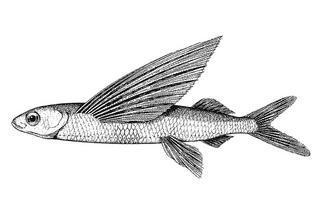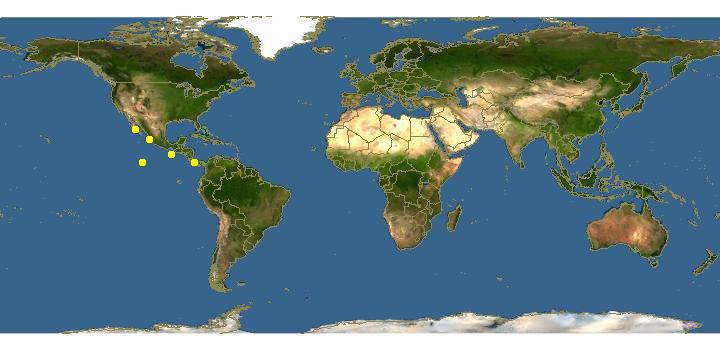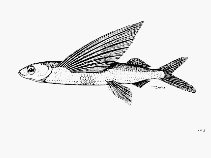
www.fao.org Copyright Michel Lamboeuf · 0
Cheilopogon papilio |

Click on map for details about points.
|
| Links |
We parsed the following live from the Web into this page. Such content is managed by its original site and not cached on Discover Life. Please send feedback and corrections directly to the source. See original regarding copyrights and terms of use.
- FishBase
|
|
espa˝ol |
|
|
Overview |
Main identification features
- d: grey
- pectoral: black, clear margin and tip
- pelvic: origin nearer tail fin base than opercle
- pelvic: black, 1st and last rays and tip clear
Top jaw not protrusible; jaws ~equal length, or lower a little longer; jaw teeth with 1 point, sometimes smaller points on sides; teeth on sides of roof of mouth; no branch of lateral line to origin of pectoral; pelvic origin nearer base of tail than rear of operculum, fin reaches past anal origin; dorsal fin 9-10 rays; anal origin under or behind 3rd dorsal ray; pectoral reaches past anal base; all pectoral rays branched, except 1st ray; juveniles with 2 fused barbels under chin and high dorsal fin.
Color Adults with pectorals black except for clear narrow margin and tip; pelvics black except for tip and first and last rays; tail and dorsal fin grey; anal transparent. Juvenile: with black chin barbels and black dorsal fin.
Size: 21 cm.
Habitat: pelagic.
Depth: surface, 0-20 m.
The lower 1/2 of the Gulf of California, Costa Rica and Panama, the Revillagigedos.
Attributes
Abundance: Common.
Cites: Not listed.
Climate Zone: Northern Subtropical (Cortez Province + Sinaloan Gap); Northern Tropical (Mexican Province to Nicaragua + Revillagigedos); Equatorial (Costa Rica to Ecuador + Galapagos, Clipperton, Cocos, Malpelo).
Depth Range Max: 20 m.
Depth Range Min: 0 m.
Diet: zooplankton; bony fishes; pelagic fish larvae; pelagic fish eggs.
Eastern Pacific Range: Northern limit=27; Southern limit=8; Western limit=-115; Eastern limit=-81; Latitudinal range=19; Longitudinal range=34.
Egg Type: Pelagic; Pelagic larva.
Feeding Group: Planktivore.
FishBase Habitat: Pelagic.
Global Endemism: Tropical Eastern Pacific (TEP) endemic; East Pacific endemic; All species.
Habitat: Water column.
Inshore Offshore: Inshore; Offshore; In & Offshore.
IUCN Red List: Not evaluated / Listed.
Length Max: 21 cm.
Regional Endemism: Island (s); Continent; Continent + Island (s); TEP endemic; All species.
Residency: Resident.
Salinity: Marine; Marine Only.
Water Column Position: Surface; Water column only;
|
|
|
Names | |
|
|
|
Links to other sites | |
|
|
|
References |
- Castro-Aguirre, J.L. and Balart, E.F., 2002., La ictiofauna de las islas Revillagigedos y sus relaciones zoogeograficas, con comentarios acerca de su origen y evolucion. En: Lozano-Vilano, M. L. (Ed.). Libro Jubilar en Honor al Dr. Salvador Contreras Balderas., Universidad Autonoma de Nuevo Leˇn:153-170.
- Clark, H.W., 1936., The Templeton Crocker Expedition of the California Academy of Sciences.1932. No. 29. New and noteworthy fishes., Proceedings of the California Academy of Sciences (Series 4), 4:21(29):383-396.
- Findley, L.T., Hendrickx, M.E., Brusca, R.C., van der Heiden, A.M., Hastings, P.A., Torre, J., 2003., Diversidad de la Macrofauna Marina del Golfo de California, Mexico., CD-ROM versiˇn 1.0. Projecto de la Macrofauna del Golfo .á Derechos reservados de los autores y Conservaciˇn Internacional.
- Fischer , W. , Krup , F. , Schneider , W. , Sommer , C. , Carpenter , K. E. and Niem, V. H., 1995., Guia FAO para la Identificacion de Especies de para los fines de la Pesca. Pacifico Centro-Oriental. Volumen II. Vertebrados - Parte 1., FAO2:647-1200.
- Lopez , M. I. and Bussing, W. A., 1982., Lista provisional de los peces marinos de la Costa Rica., Revista de Biologia Tropical, 30(1):5-26.
- Love, M.S., Mecklenburg, C.W., Mecklenburg, T.A., Thorsteinson, L.K., 2005., es of the West Coast and Alaska: a checklist of North Pacific and Artic Ocena species from Baja California to the Alaska-Yukon border., U.S. Department of the Interior, U.S. Geological Survey, Biological Resources Division, 288pp.
- Van der Heiden , A. M. and Findley, L. T., 1988., Lista de los peces marinos del sur de Sinaloa, MÚxico., Anales del Centro de Ciencias del Mar y Limnologia de la Universidad Autonoma Nacional de Mexico, 15:209-224.
|
|
|
Acknowledgements | |
I thank Ashley MacDonald and John Pickering, University of Georgia, for technical support in building this page.
|
|
| Supported by | |
|
Following modified from FishBase
|
Top | See original
http://www.fishbase.org/Summary/speciesSummary.php?genusname=Cheilopogon&speciesname=papilio ---> http://192.134.151.83/Summary/speciesSummary.php?genusname=Cheilopogon&speciesname=papilio
http://192.134.151.83/Summary/speciesSummary.php?genusname=Cheilopogon&speciesname=papilio ---> https://fishbase.mnhn.fr/Summary/speciesSummary.php?genusname=Cheilopogon&speciesname=papilio
https://fishbase.mnhn.fr/Summary/speciesSummary.php?genusname=Cheilopogon&speciesname=papilio ---> https://fishbase.mnhn.fr/summary/Cheilopogon-papilio.html
Cheilopogon papilio, Butterfly flyingfish

You can
sponsor
this page
Common name (e.g. trout)
Genus + Species (e.g. Gadus morhua)
-

-
About this page
-
Languages
-
User feedbacks
-
Citation
-
Uploads
-
Related species
-


 Butterfly flyingfish
Add your observation in
Fish Watcher
Upload your
photos
and
videos
Butterfly flyingfish
Add your observation in
Fish Watcher
Upload your
photos
and
videos
Pictures
|
Google image
 Cheilopogon papilio
Cheilopogon papilio
Picture by
FAO
Teleostei (teleosts) >
Beloniformes
(Needle fishes) >
Exocoetidae
(Flyingfishes)
Etymology:
Cheilopogon:
Greek, cheilos = lip + Greek, pogon = barbed, beard (Ref.
45335
)
.
Environment: milieu / climate zone / depth range / distribution range
Ecology
Marine; pelagic-neritic; oceanodromous (Ref.
51243
); depth range 0 - ? m. Tropical; 26°N - 8°N
Eastern Central Pacific: Mexico and Costa Rica.
Size / Weight / Age
Maturity: L
m
?
range ? - ? cm
Max length : 21.0 cm SL male/unsexed; (Ref.
9300
)
Epipelagic in coastal waters. May leap out of the water and glide for considerable distances above the surface.
Life cycle and mating behavior
Maturity
|
Reproduction
|
Spawning
|
Eggs
|
Fecundity
|
Larvae
Parin, N.V.
, 1995. Exocoetidae. Peces voladores. p. 1091-1103. In W. Fischer, F. Krupp, W. Schneider, C. Sommer, K.E. Carpenter and V. Niem (eds.) Guia FAO para Identification de Especies para lo Fines de la Pesca. Pacifico Centro-Oriental. 3 Vols. FAO, Rome. (Ref.
9300
)
IUCN Red List Status (Ref.
130435
)
Least Concern (LC)
; Date assessed:
01 May 2008
CITES
Not Evaluated
Not Evaluated
Threat to humans
Harmless
Human uses
FAO - Publication:
search
|
FishSource
|
More information
Countries
FAO areas
Ecosystems
Occurrences
Introductions
Stocks
Ecology
Diet
Food items
Food consumption
Ration
Common names
Synonyms
Metabolism
Predators
Ecotoxicology
Reproduction
Maturity
Spawning
Spawning aggregation
Fecundity
Eggs
Egg development
Age/Size
Growth
Length-weight
Length-length
Length-frequencies
Morphometrics
Morphology
Larvae
Larval dynamics
Recruitment
Abundance
BRUVS
References
Aquaculture
Aquaculture profile
Strains
Genetics
Electrophoreses
Heritability
Diseases
Processing
Nutrients
Mass conversion
Collaborators
Pictures
Stamps, Coins Misc.
Sounds
Ciguatera
Speed
Swim. type
Gill area
Otoliths
Brains
Vision
Tools
E-book
|
Field guide
|
Length-frequency wizard
|
Life-history tool
|
Point map
|
Classification Tree
|
Catch-MSY
|
Special reports
Check for Aquarium maintenance
|
Check for Species Fact Sheets
|
Check for Aquaculture Fact Sheets
Download XML
Summary page
|
Point data
|
Common names
|
Photos
Internet sources
AFORO (otoliths) |
Aquatic Commons
|
BHL
|
Cloffa
|
BOLDSystems
|
Websites from users
|
Check FishWatcher
|
CISTI
|
Catalog of Fishes
:
genus
,
species
|
DiscoverLife
|
ECOTOX
| FAO - Publication:
search
|
Faunafri
| Fishipedia |
Fishtrace
| GenBank:
genome
,
nucleotide
| GloBI |
Google Books
|
Google Scholar
|
Google
| IGFA World Record |
MitoFish
|
Otolith Atlas of Taiwan Fishes
|
PubMed
| Reef Life Survey | Socotra Atlas |
Tree of Life
| Wikipedia:
Go
,
Search
| World Records Freshwater Fishing |
Zoological Record
Estimates based on models
Phylogenetic diversity index (Ref.
82804
): PD
50
= 0.5000 [Uniqueness, from 0.5 = low to 2.0 = high].
Bayesian length-weight: a=0.00646 (0.00292 - 0.01429), b=3.04 (2.84 - 3.24), in cm total length, based on LWR estimates for this (Sub)family-body shape (Ref.
93245
).
Trophic level (Ref.
69278
): 3.6 ±0.5 se; based on size and trophs of closest relatives
Resilience (Ref.
120179
): High, minimum population doubling time less than 15 months (Preliminary K or Fecundity.).
Fishing Vulnerability (Ref.
59153
): Low vulnerability (16 of 100).
Back to Search
Random Species
Back to Top
Accessed through:
Not available
FishBase mirror site :
localhost
Page last modified by :
mrius-barile
- 20 July 2016
Fatal error
: Uncaught ArgumentCountError: Too few arguments to function checkEcotox(), 1 passed in /var/www/html/summary/speciessummary.php on line 2304 and exactly 3 expected in /var/www/html/includes/speciessummary.lib.php:2579 Stack trace: #0 /var/www/html/summary/speciessummary.php(2304): checkEcotox() #1 {main} thrown in
/var/www/html/includes/speciessummary.lib.php
on line
2579
|
Updated: 2024-05-23 03:03:38 gmt
|